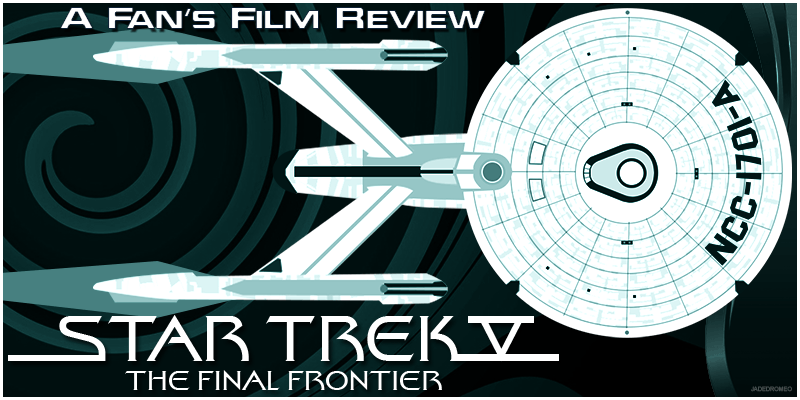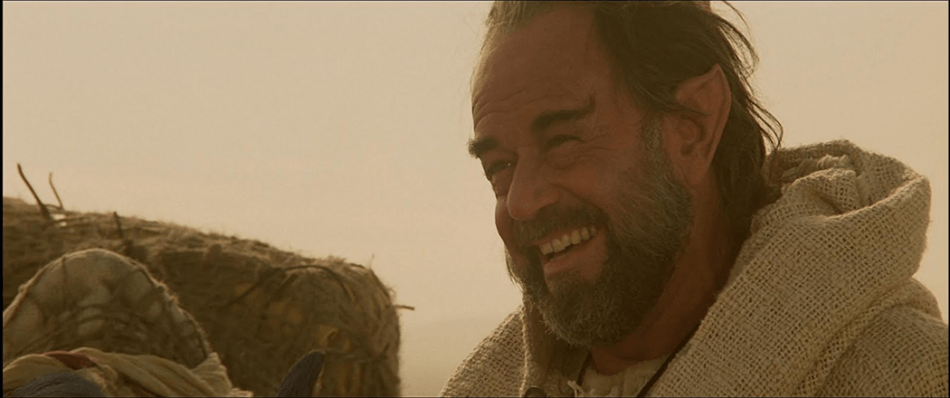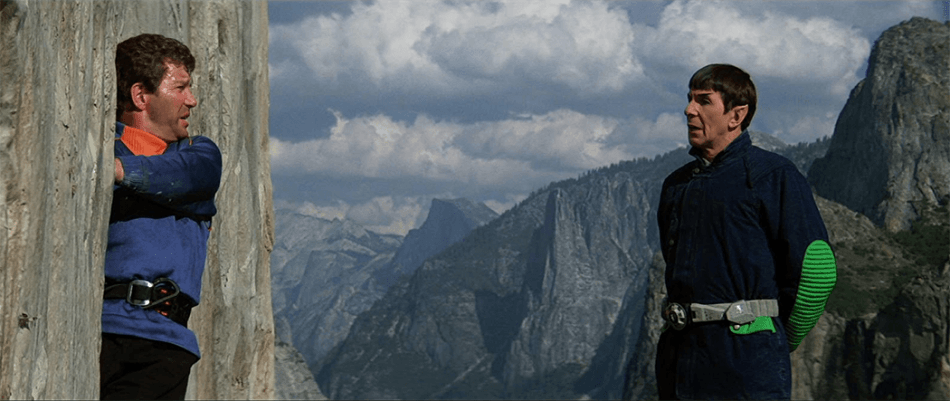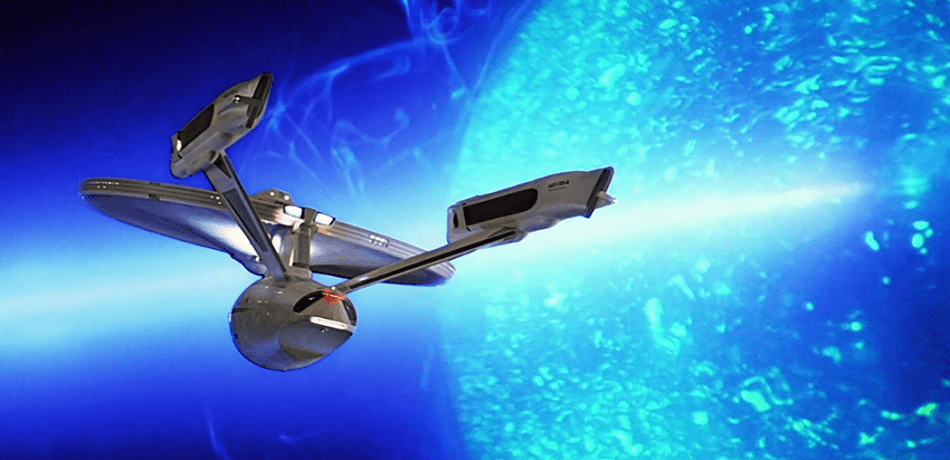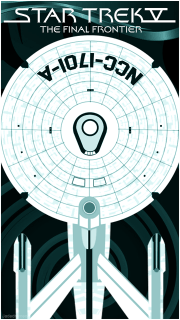 Over the past few weeks, I have been having tremendous fun reviewing the Star Trek films, offering insights on their making and reminiscing about where I was at the time of each film’s release. (I hope I have jarred some sweet memories for all of you as well.) Now, we come up to the very film that this page is all about…Star Trek V: The Final Frontier, a film that caused many of us some angst at the time of its release but has since grown in our hearts, not only through nostalgia but by the simple fact that even worse Star Trek films have since been made.
Over the past few weeks, I have been having tremendous fun reviewing the Star Trek films, offering insights on their making and reminiscing about where I was at the time of each film’s release. (I hope I have jarred some sweet memories for all of you as well.) Now, we come up to the very film that this page is all about…Star Trek V: The Final Frontier, a film that caused many of us some angst at the time of its release but has since grown in our hearts, not only through nostalgia but by the simple fact that even worse Star Trek films have since been made.
1989 was not a particularly good year for me. My stepdad had retired from the Air Force the previous year and we went from living on an Air Force Base in Idaho to civilian life in Sussex County, New Jersey for what would easily be the worst two years of my life. It was quite a culture shock for an already-awkward 15-year-old. On top of that, my real dad (still in the Air Force) was doing a yearlong tour of duty in Osan Air Base in Korea, separating him not only from me and my brother but all of his family.
In was a difficult year for Hollywood as well. There was a Writer’s Guild strike and a teamster strike, which caused problems for not only Star Trek V, but also just about every production in Hollywood that year. There also seemed to be a shortage of ideas compared to earlier in the decade. The summer of ’89 was “the summer of sequels”. Virtually every film that came out that year was a sequel: Star Trek V, Indiana Jones and the Last Crusade, License To Kill, Lethal Weapon 2, The Karate Kid Part III, Ghostbusters II, etc. I can only recall one major release that summer that wasn’t a sequel, Tim Burton’s Batman, and even that was based on an already well-established franchise.
Given how poor we were when we lived in New Jersey, we could only afford to see one film at the movies that summer and it wound up being Indiana Jones and the Last Crusade. While I can honestly say that I think it was a good choice and that Indy III was my favorite film of that year, it did lead to a minor regret that I still carry today: of the twelve Star Trek films released at this writing, The Final Frontier is the only one I have not seen in a movie theater. On top of that were the bad reviews coming in both of the papers and even in readers’ comments in Starlog magazine. (The last place in the world I would have ever expected to see anyone spew bile about a Star Trek movie.) As a young fan that only ever wanted to see Star Trek on the top, particularly when William Shatner was directing, this was very disheartening.
However, The Final Frontier’s release wasn’t ALL doom and gloom for me. For one thing, I actually have something of a quasi-familial connection to this film. The exteriors of Paradise City and the desert world of Sha Ka Ree were shot near Trona Peaks, California, where my dad’s old Air Force roommate, Bill Surgett, just happened to be living at the time. Bill managed to get himself a job as an extra on the film as one of Sybok’s followers and even wrote a journal about his incredible five-day experience going through costume, make-up (which was only dirt and water), intense heat, learning the “Sybok shuffle”, and even getting to have lunch with William Shatner himself that had us beaming with pride. Also, my dad was fortunate enough to have wrapped up his tour at Osan just in time to catch the film at the tail end of its run at a second-run movie theatre as a coming home present from his then-wife, which made me feel happy that HE got to see it in a theatre at least.
When first released, The Final Frontier was predicted to be one of the biggest hits of the summer of 1989 and it did have the biggest opening weekend of any Star Trek film up to that time, but it dropped like a stone after that and in the end managed an overall domestic gross of $52 million against a $23 million budget. And while returning a gross more than twice a film’s cost would make it a box-office hit by ANY OTHER standards, Star Trek is held up to a higher standard, and the film suffered, particularly when compared to its admittedly superior three predecessors; The Wrath of Khan, The Search for Spock, and The Voyage Home, making The Final Frontier the first to not do better than its predecessor critically or commercially.
One of the main reasons for the film’s “failure” was that the special effects were not up to the standard that we had gotten used to in the first four features. With ILM unavailable, Shatner and Paramount turned to Bran Ferren and Associates for visual effects work and while they did a pretty good job animating Audrey II in Frank Oz’s Little Shop of Horrors, the optical composition required to make the starship Enterprise fly seemed to be a bit out of his league. (To be fair, NONE of the blockbusters in the summer of ’89 seemed to excel in the special effects front. Even ILM seemed to be having an “off day” in Indy III with a shot of a crashed tank rolling in a canyon that was obviously a model.)
Add to that the premiere of Star Trek: The Next Generation had ripped up and/or redecorated all of the sets and Herman Zimmerman was tasked with creating a look for the film that was essentially a “pre-TNG” aesthetic. Lee Cole’s wonderful graphics were gone, replaced by Okudagrams on regular TV screens. The visual flavour that I loved from the first three films was gone.
However, even bad effects can be overcome by a good and poignant story, but with The Final Frontier coming off of the heels of the Genesis trilogy, it was hard for it to come off as just another adventure at best.
Since that time, however, I have seen opinions on this film softened somewhat and my own opinion has softened as well. (By ‘softened’, I mean we look back and say, “Well…it’s not THAT bad.”) Years of nostalgia, the fact that this (thankfully) did not prove to be the original cast’s swansong, and the fact that other films have been made since then that have garnered even worse fan reactions have lifted The Final Frontier from the bottom of the barrel. But while TFF may no longer hold the title of Worst Star Trek Film Ever Made, it does still qualify as the most poorly constructed.
That is where the Petition For A Star Trek V Special Edition came in. As you all know, TrekWeb’s Gustavo Leao has been spearheading a campaign to Paramount to allow Mr Shatner to have the same opportunity that they had given Robert Wise for Star Trek: The Motion Picture, the chance to re-edit and revise the film so that it would at the very least look better and have more kinetic excitement. Part of Mr Leao’s effort had been to construct a fan edit of the film to present to Paramount and/or director William Shatner in an effort to convince them that a revised edition could work for this film just as it had for TMP. To that end, he recruited the talents of two up-and-coming FX artists, Wil Jaspers and PhineasBg, to create a fan edit of The Final Frontier, and the results are amazing!
The first and most obvious order of business was for them to create all-new special effects shots that are light years ahead of the bland work done for the original official cut. One area where they took the opposite approach from the TMP Director’s edition was the resolution. Where the FX artists on the TMP-DE went through painstaking effort to get the right amount of dirt and grain to help the new footage blend seamlessly with the old, Jaspers and Phineas opted to use a high-definition transfer of TFF, with the richer and deeper colors as well as separation between colors and the crispest and clearest print available. The result is a new version of the film that is clean, colourful, and better presented than before.
Particular standout sequences include the Bird of Prey shooting the floating satellite, which now takes place near a star and thus is awash in sunlight, the shuttlecraft’s docking with the Enterprise in Earth orbit, a wonderful new zoom-in sequence from the exterior of the ship into one of the forward windows where Spock is contemplating in the forward lounge, the shuttlecraft crash and battle scene, and the Enterprise’s journey through the Great Barrier.
However, as with the TMP Director’s Edition, nearly equal importance is given to what is cut out as much as what is put in. The poorly matted shot’s of Kirk’s fall from El Capitan are removed, making the fall faster and more kinetic. And the climb up the deck shaft cleverly removes most of the deck numbers from the shaft walls- a big eyesore for fans for years!
But the biggest standout scene- and the one I was most looking forward to- was the emergence of the false “God’s” true form…a rock-like creature of fierce power and creepiness. While it’s not as spectacular as Shatner may have envisioned in the beginning (he had initially wanted six such creatures for the climax), Jaspers and Phineas made clever use of some test-screening footage that was available as well along with CG renditions of the creature and other film elements to create a sequence where Kirk narrowly escapes the creature’s clutches.
Ironically, however, it’s the scenes throughout the film where only subtle changes have been made that seem to have little impact yet may have been the most difficult for Jaspers and Phineas to have accomplished. Every sequence no doubt had to be painstakingly remastered frame-by-frame to create this grand new look for the film. The rock-like “God” creature may have been more exciting to watch, but the new shimmer surrounding the false image of God with light bouncing off of our characters may have been a task of even greater magnitude for them.
As for the story itself, something interesting happens whenever I watch a new version of a story I’m already familiar with. It takes on a new level of urgency and deeper meaning than it had before. The themes of man’s quest to find God or deep spiritual meaning, which I admit were completely lost on me when the film first came out when I was a teenager, become far more relatable as you grow older and start to contemplate such things along with your mortality. Just as TMP could get us asking the question “Is this all that I am…is there nothing more?” and pondering the meaning of existence, this film can get us thinking about how we often don’t make the right choice in life…and that’s okay. Kirk says it best in his speech about how pain and guilt are part of our makeup as human beings, and to lose that is to lose ourselves. It has been said that he who tries to live only the “good” parts of life ends up not living at all, and that is at the heart of the story when Kirk says, “I don’t want my pain taken away! I NEED my pain!”
Ultimately, however, any upgrades in the visual effects and in editing can only complement the story for those who already appreciate it. It won’t solve any deficiencies in David Loughery’s script or change the minds of anyone who thinks this film is a low chapter in Star Trek’s history. But it isn’t made for them. Like the Director’s Edition of TMP, it is made for those who already appreciate the themes, understand what Shatner was trying to accomplish, and understand filmmaking enough to sympathize with the troubled production. We are the Star Trek V Appreciation Society not because we think this is the best Star Trek film (let’s face it, it’s far from it), but because we appreciate how Star Trek– even at its worst- can still generate a story that gets us thinking about the human condition and spirituality and leave us with feelings of goodwill for the characters. And although it may be the most poorly constructed Star Trek film, even its original theatrical cut is better than Beneath the Planet of the Apes, Superman IV, or Alien 3 any day. (In fact, me personally, I’ll take the worst Star Trek film over the best Alien film any day!)
I’m going to do something unusual here and rate Star Trek V: The Final Frontier on two scales. For the film itself, I give a 5 on the 1-to-10 scale. I know that seems awfully generous to some but it takes a lot for me to go down to a 2 or a 1. A film has to really tick me off to get a score that low and no Star Trek film to date has ever done that and hopefully never will. Besides, the aforementioned quasi-familial connection does make me a little biased in this film’s favour For the effort to upgrade the film I give it a 9; I am once again touched by the heartfelt effort that fans are willing to put into a story that they love, whether it’s an all-new Star Trek story or an attempt to lift up a fallen chapter.

